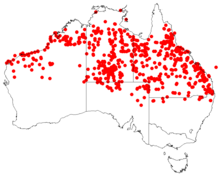Description
Indigofera linnaei is a spreading, usually prostrate woody herb, 15–50 cm high with a long taproot, [8] which forms a flat mat up to 1.5 m across, and up to 45 cm high. [6] The compound leaves are up to 3 cm long, with (generally) 7 or 9 obovate, alternate leaflets which have a mucronate apex and are about 8–15 mm long and 2–5 mm wide. The stipules are lanceolate (shaped like a lance-head) and about 5 mm long with broad, dry margins. [8] [9] The inflorescences are dense and up to 2 cm long. The calyx is covered with spreading, white hairs. The petals are red. [8] The standard slightly exceeds the calyx, and the wings and keel are shorter. [9] The pod is oblong and silky, about 3–7 mm long, pointed at apex, and usually contains two seeds. [8]
The branches are covered with appressed white hairs; leaves peltate, 3–5 cm long; leaflets 7–9, obovate-cuneate, 8-13 x 2–5 mm, mucronate, sericeous on both sides; stipules c. 3 mm long, lanceolate, lateral, free, sericeous. The inflorescence is a subsessile, dense, a glomerule-like spike, 1–2 cm long. It is few- to 25-flowered, with bracts lanceolate, 3–4 mm long, pubescent, scarious, with a strong central vein terminating in an acuminate tip. The flowers are sessile, about 5 mm long; calyx campanulate, 3–5 mm long, villous, the narrow acuminate teeth much longer than the tube. The petals red; standard obovate-spathulate, slightly exceeding the calyx; wings and keel shorter, inserted. [9]
In the Northern Territory, it is a weedy species often found in disturbed or overgrazed areas and on a variety of soils from skeletal soils and red sand to cracking clay. [10] It flowers and fruits in all months of the year. [10]
In Western Australia, it flowers from January to May, and is found on sandy soils, on sandstone & limestone ridges, along rivers and creeks, and on rocky hillsides. [11] It is not considered a species of conservation concern in Western Australia to according to the Declared Rare and Priority Flora List. [11]
Toxicity
It took considerable time before it was recognised as the plant which gave horses the "Birdsville" disease (a disease of horses in arid and semi-arid Australia), [12] with the causal agent being suspected by Everist [6] as being indospicene [13] or possibly cavananine . [6] However, current research indicates that the neurotoxic effects on horses with Birdsville disease are due to the neurotoxin 3 nitropropionic acid (3-NPA), with horses less susceptible than cattle to the hepatotoxic effects of indospicene. [12] The neurotoxic effect on horses generally occurs just after the rains, because I. linneai responds more quickly to moisture than other species. [12]
Nonetheless, indospicene (also spelled indospicine) accumulates in the tissues of grazing livestock after ingestion of Indigofera , causing both liver degeneration and abortion across animal species but the degree varies considerably between species. The magnitude of sensitivity in dogs is such that consumption of indospicine-contaminated horse and camel meat has caused secondary poisoning of dogs. [14] Livestock grazing Indigofera have a chronic and cumulative exposure to this toxin, with such exposure experimentally shown to induce both hepatotoxicity and embryo-lethal effects in cattle and sheep. [14]
This page is based on this
Wikipedia article Text is available under the
CC BY-SA 4.0 license; additional terms may apply.
Images, videos and audio are available under their respective licenses.

